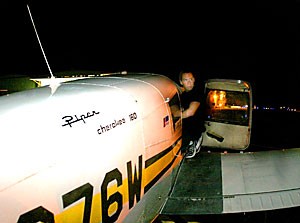Ever wanted to get really high?
The UA Flying Club took prospective members 1,000 feet above the ground in three single-engine propeller planes Friday night at an introductory meeting held at Ryan Airfield, about 12 miles southeast of campus on West Ajo Way.
For $20 a semester, club members get to go on flights in the four-seat aircrafts, listen to aviation experts and take ground school courses, which is the first step toward becoming a pilot, said David Hahs, Flying Club president and an aerospace and mechanical engineering senior.
“”We do introduction flights,”” he said. “”In a couple weeks, we’ll be flying people up to Marana. They have a nice little airport there where you can get breakfast or lunch.””
Other flights include a trip to Casa Grande for the Experimental Aircraft Association fly-in, which features about 400 airplanes and expert pilots, Hahs said.
“”We’ll go out to Chandler or Deer Valley north of Phoenix,”” Hahs said. “”We get three or four airplanes together, fly out there, grab lunch and then fly back here.””
Members also have the opportunity to take free ground school training from a certified flight instructor to learn the basics of operating an aircraft, Hahs said, adding that the courses usually cost between $300 and $400.
Ground school is required to get a license, Hahs said. Then one must purchase a training package from a flight school and spend at least 40 hours in the air with a certified instructor.
In addition to flights and ground school, members also get to talk to aviation experts at club meetings, held at the Aerospace and Mechanical Engineering building every other Wednesday.
“”We bring in speakers from the ROTC Air Force Colonel to commercial pilots to flight instructors, to talk about anything students might be interested in,”” he said.
Hahs said he got his pilot’s license at 19, during his freshman year, even though he previously had no plans of getting one.
“”It just happened that I got here and I was lucky enough to have a flight instructor in the club,”” he said. “”I got my license for about half the price it normally is.””
Hahs said he has spent the last two summers as an intern for the Boeing Company in Seattle. He has worked on the construction of the F-22 fighter jet and the 787 Dreamliner, a new airplane intended to be more fuel-efficient than current models.
Two of the planes the club uses are owned by its faculty advisers, physics professor Bill Bickel and retired physics professor Charles Curtis. Both Bickel and Curtis take members up in the planes from the hangar they share at Ryan Airfield.
Bickel, a UA professor for 43 years, owns a restored red 1956 Cessna 170, Hahs said.
Another plane used by the club, a Piper Cherokee 160, is owned by club treasurer Eric Hoffman-Watt and his father.
Hoffman-Watt, an aerospace engineering senior, has been flying since he was 16, getting his private pilot’s license at 17.
“”I took most of the ground school myself,”” he said, adding that his longest flight took him from Ryan Airfield to Nebraska to visit family, a trip of about 10 hours.
Less than half of the club’s members are actually pilots, Hahs said.
“”The other half are people who are interested in aviation and want to learn about it,”” he said. “”Especially for students, it’s a great opportunity to go flying and not have to pay very much money.””
Tiara Patten, a pre-pharmacy sophomore, was at the club’s introductory meeting to take a flight and learn more about becoming a pilot.
“”I’d actually like to get my pilot’s license,”” she said. “”That way, if I have a well-enough paying job, I could get a plane. Instead of driving somewhere, I’d just fly … that’d be cool.””









